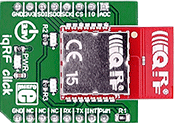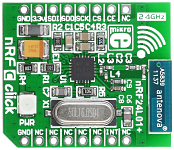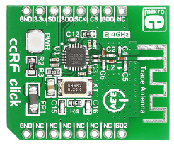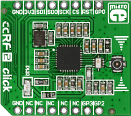 |

|
|
IQRF click carries the DCTR-76DA RF transceiver, operating in the 868/916 MHz frequency. The click is designed to run on a 3.3V power supply. It communicates with the target microcontroller over SPI or UART interface, with additional functionality provided by the following pins on the mikroBUS™ line: AN, RST, PWM, INT. |
|
|
|
 |

|
|
nRF T Click is an add-on board in the mikroBUS form factor. It features the Nordic nRF24L01P 2.4 GHz transceiver module with an embedded baseband protocol engine as well as 2.4 GHz PCB trace antenna. The board supports an air data rate of 250 Kbps, 1 Mbps and 2 Mbps and it is suitable for ultra low power designs. Typical applications include wireless PC peripherals, remotes, VoIP headsets, game controllers, sensors, home and commercial automation, active RFID, toys, etc. nRF C Click communicates with the target board microcontroller via mikroBUS SPI (SDI, SDO, SCK, CS#), CE and INT lines. The board is designed to use a 3.3V power supply only. |
|
|
|
 |

|
|
nRF C Click is an add-on board organised in the mikroBUS form factor. It features a Nordic nRF24L01P 2.4 GHz transceiver module with an embedded baseband protocol engine as well as 2.4 GHz SMD chip antenna. The board supports an air data rate of 250 Kbps, 1 Mbps and 2 Mbps and it is suitable for ultra low power designs. Typical applications include wireless PC peripherals, remotes, VoIP headsets, game controllers, sensors, home and commercial automation, active RFID, toys, etc. nRF C Click communicates with the target board microcontroller via mikroBUS SPI (SDI, SDO, SCK, CS#), CE and INT lines. The board is designed to use a 3.3V power supply only. |
|
|
|
 |

|
|
The nRF S click is a compact and easy solution for adding a 2.4 GHz transceiver to your design. It features a nRF24L01P 2.4 GHz transceiver module with an embedded baseband protocol engine as well as an SMA antenna connector (antenna sold separately). The board supports an air data rate of 250 Kbps, 1 Mbps and 2 Mbps and it is suitable for ultra low power designs. Typical applications include wireless PC peripherals, remotes, VoIP headsets, game controllers, sensors, home and commercial automation, active RFID, toys, etc. nRF S click communicates with target board microcontroller via mikroBUS SPI (SDI, SDO, SCK, CS#), CE and INT lines. The board is designed to use a 3.3V power supply only. |
|
|
|
 |

|
|
ccRF click is a low-power 2.4 GHz transceiver designed for the 2400- 2483.5 MHz ISM and SRD frequency bands. It features the CC2500 Low-Power 2.4 GHz RF transceiver as well as PCB trace antenna. The CC2500 is integrated with a highly configurable baseband modem that supports various modulation formats and has data rate up to 500 kBaud. Maximum device range is up to 20 meters in open space. ccRF click communicates with the target microcontroller via mikroBUS SPI, RST and PWM lines. The board is designed to use 3.3V power supply only. All these features make this board ideal for consumer electronics, wireless audio, wireless keyboard and mouse RF remote controls. |
|
|
|
 |

|
|
ccRF2 click carries CC1120, the fully integrated, high-performance single-chip radio transceiver with extremely low power consumption. Designed mainly for the ISM (Industrial, Scientific, and Medical) and SRD (Short Range Device) frequency bands at 164–192 MHz, 274–320 MHz, 410–480 MHz, and 820–960 MHz, CC1120 provides extensive hardware support for packet handling, data buffering, burst transmissions, clear channel assessment, link quality indication, and Wake-On-Radio. It also has exceptional receiver sensitivity. ccRF2 click communicates with the target board through mikroBUS SPI (MISO, MOSI, CSK), and AN, RST, CS, PWM and INT lines. The board is designed to use a 3.3V power supply. |
|
|
|
 |

|
|
tRF Click is an add-on board in the mikroBUS form factor. It can be used to wirelessly send and receive UART data. It features the Telit LE70-868 868MHz transceiver module with an embedded stack that is easy to integrate and use in point-to-point or star network topologies. The click board also carries an SMA connector for an antenna as well as two radio communication LEDs. It enables radio data rates from 4.8 to 57.6 kbps with maximum output power of 500mW and a range of up to 10km in ideal conditions (open space), and about 4km in mixed conditions. The board is designed to use a 3.3V power supply only. An LED diode serves as a power indicator. |
|
|
|
 |
|

